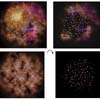| . |  |
. |
Seattle WA (SPX) Mar 16, 2005 Scientists trying to recreate conditions that existed just a few millionths of a second after the big bang, that started the universe, have run into a mysterious problem � some of the reactions they are getting don't mesh with what they thought they were supposed to see. Now, two University of Washington physicists have dusted off a quantum mechanics technique usually associated with low-energy physics and applied it to results from experiments at Brookhaven National Laboratory on New York's Long Island, that produce high-energy collisions between gold nuclei. The result is data much more in line with what theorists expected from the experiments, said John Cramer, a UW physics professor. That means physicists at Brookhaven probably have actually succeeded in creating quark-gluon plasma, a state of matter that has not existed since a microsecond after the big bang that began the universe. As it turns out, the model the physicists were using was missing some pieces, say Cramer and Gerald Miller, also a UW physics professor, whose findings will be published this month in Physical Review Letters, a journal of the American Physical Society. "We think we've solved the puzzle by identifying important phenomena that were left out of the model," Cramer said. Since 2000, scientists have been using the Relativistic Heavy Ion Collider at Brookhaven to collide gold nuclei with each other at nearly the speed of light. They are trying to get subatomic particles called quarks and gluons to separate from the nuclei and form a superheated quark-gluon plasma, 40 billion times hotter than room temperature. Physicists used a technique called Hanbury Brown-Twiss Interferometry, originally used by astronomers to measure the size of stars, to learn the size and duration of a fireball produced in the collision of two gold nuclei. The technique focuses on momentum differences between pairs of pions, the particles produced in the fireball. Before the collider experiment began, scientists expected a quark-gluon plasma to fuel a large and long-lasting fireball. Instead, the interferometry data showed a fireball similar in size and duration to those seen at much lower energies. Researchers also expected to see pions pushed out of the plasma gradually, but instead they seem to explode out all at once. "We expected to bring the nuclear liquid to a boil and produce a steam of quark-gluon plasma," Cramer said. "Instead, the boiler seems to be blowing up in our faces." While other evidence suggested that the collider experiment had created a quark-gluon plasma, the interferometry data pointed away from that possibility. To solve the puzzle, Cramer and Miller used a phenomenon called chiral symmetry restoration, which predicts that subatomic particles will change in mass and size depending on their environment � in a hot, dense plasma as opposed to a vacuum, for instance. By adding that process to the model, they found that pions in the plasma have to expend a large amount of energy to escape, as if they were stuck in a deep hole and had to climb out. That is because chiral symmetry gives pions a low mass when they are inside the plasma but a much higher mass once outside. The scientists also allowed for some pions to disappear completely, to transform into some other type of particle as they emerge from the plasma. The result reconciles all the evidence from the collider experiments, supporting the possibility that a quark-gluon plasma actually has been created. "We have taken a quantum mechanics technique, called the nuclear optical model, from an old and dusty shelf and applied it to puzzling new physics results," Miller said. "It's really a scientific detective story." The work, supported by U.S. Department of Energy grants, adds to the general understanding of what happened in the first microseconds after the big bang, he said, "and what we bring to bear is a better microscope, the microscope of quantum mechanics." Cramer noted that adding chiral symmetry restoration to the picture achieved results very close to what computer models told scientists to expect, and did so without forcing the experimental data to fit preconceived standards. "A microsecond after the big bang, there was a state of matter that no one was able to investigate until very recently," he said. "We are still learning, but our understanding is growing." Related Links University of Washington SpaceDaily Search SpaceDaily Subscribe To SpaceDaily Express
 Paranal, Chile (SPX) Mar 16, 2005
Paranal, Chile (SPX) Mar 16, 2005On the basis of stellar spectra totalling more than 200 hours of effective exposure time with the 8.2-m VLT Kueyen telescope at Paranal (Chile), a team of astronomers [1] has made a surprising discovery about the stars in the giant southern globular cluster Omega Centauri. |
|
| The content herein, unless otherwise known to be public domain, are Copyright 1995-2006 - SpaceDaily.AFP and UPI Wire Stories are copyright Agence France-Presse and United Press International. ESA PortalReports are copyright European Space Agency. All NASA sourced material is public domain. Additionalcopyrights may apply in whole or part to other bona fide parties. Advertising does not imply endorsement,agreement or approval of any opinions, statements or information provided by SpaceDaily on any Web page published or hosted by SpaceDaily. Privacy Statement |